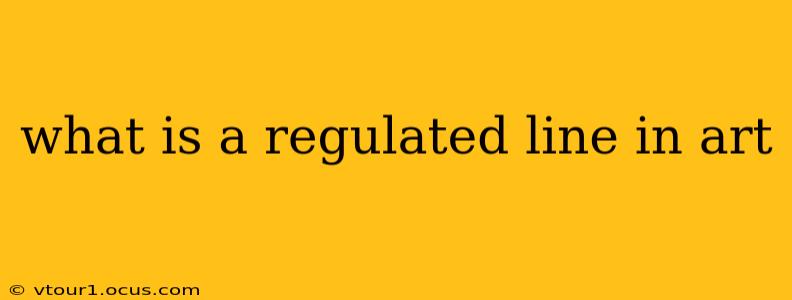A regulated line in art refers to a line that is controlled, precise, and deliberate in its execution. Unlike a free-flowing, expressive line, a regulated line exhibits a sense of order, precision, and often, mathematical or geometrical properties. It's a line that showcases the artist's conscious decision-making process and meticulous control over their mark-making. The effect can range from conveying a sense of calm and stability to creating a feeling of rigidity and constraint, depending on the context and the artist's intent.
This concept isn't about a specific style or technique; rather, it describes a quality of line. It can be found across many artistic movements and mediums, including drawing, painting, sculpture, and even architecture. Let's explore some key aspects:
How is a Regulated Line Achieved?
Several techniques and approaches contribute to the creation of a regulated line:
-
Tools and Materials: The choice of tools significantly influences the line's regulation. A fine-tipped pen or a sharp pencil allows for greater precision than a broad brush or charcoal stick. Rulers, compasses, and other drafting tools are frequently used to ensure straight lines and precise curves.
-
Planning and Measurement: Artists often employ preliminary sketches, grids, or other planning methods to establish the path and characteristics of their regulated lines before committing them to the final artwork. Careful measurement and calculations are common, particularly in geometric or architectural representations.
-
Repetition and Pattern: The repetition of lines, often at regular intervals or in structured patterns, is a hallmark of regulated lines. This methodical repetition creates a visual rhythm and structure that reinforces the sense of control and order.
-
Consistent Pressure and Speed: Maintaining consistent pressure on the drawing instrument and a steady speed throughout the line's creation contributes to its regulated appearance. Variations in pressure and speed can introduce irregularities and disrupt the controlled effect.
What are the Effects of Regulated Lines in Art?
The impact of regulated lines varies depending on the context but often includes:
-
Precision and Accuracy: Regulated lines immediately convey a sense of meticulous attention to detail and accuracy. This is crucial in technical drawings, architectural renderings, and other works where precision is paramount.
-
Order and Structure: The controlled nature of regulated lines establishes order and structure within the artwork. This can create a sense of stability, harmony, and balance.
-
Calmness and Serenity: In some instances, the controlled precision of regulated lines can evoke a sense of calm, serenity, and even meditative quality.
-
Rigidity and Constraint: Conversely, an overreliance on rigidly regulated lines can sometimes feel stiff, mechanical, or emotionally restrained, depending on the overall aesthetic.
What are some examples of regulated lines in art?
Examples abound across art history and styles:
-
Renaissance perspective drawings: The use of perspective relies heavily on precisely drawn lines to create the illusion of depth and space.
-
Geometric abstract art: Artists like Piet Mondrian famously employed regulated lines to create structured compositions based on geometric forms.
-
Technical drawings and blueprints: These require absolute precision and utilize regulated lines to convey detailed information.
-
Engravings and etchings: The fine lines created through these techniques often display a high degree of regulation and control.
Are regulated lines always straight?
No, regulated lines aren't necessarily straight. They can also include precisely controlled curves, arcs, and other geometric forms created with the help of tools or careful planning. The key is the control and deliberation involved in their creation.
What's the difference between a regulated line and a free line?
The core difference lies in the artist's approach. A regulated line is carefully planned and executed, emphasizing precision and control. A free line, on the other hand, is spontaneous, expressive, and allows for greater freedom and variation in the mark-making process. Often, the contrast between regulated and free lines within a single piece can create dynamic visual effects.
